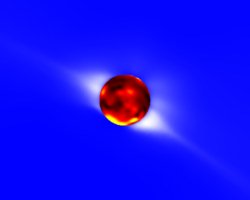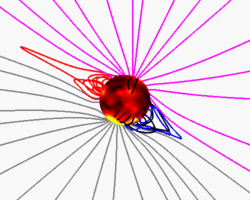

| Prediction of the Structure of the Solar Corona During the March 9, 1997 Solar Eclipse |
|---|
Predicted polarization brightness (pB) and traces of the magnetic field lines, in arbitrary colors, in the solar corona for March 9, 1997, at 1:00 UT (corresponding to a Carrrington longitude of 257 degrees at central meridian). The pB signal is produced by white light scattered off electrons in the coronal plasma. The brightest regions, known as helmet streamers, occur where the magnetic field lines are closed. The image has been radially detrended to account for the fall-off of coronal brightness with distance from the Sun. Vertical (top) is geocentric (Terrestrial) north. This is the view of the Sun that would be seen by an observer on Earth with a camera aligned so that vertical is toward the Earth's north pole. Click the images for high resolution JPEG (10 Kbytes) and GIF (14 Kbytes) images.
Predicted pB and traces of the magnetic field lines for the same calculation as above; here vertical (top) is heliocentric (solar) north. This is the view of the Sun that would be seen by an observer on Earth with a camera aligned so that vertical is toward the Sun's north pole. Click the images for high resolution JPEG (10 Kbytes) and GIF (14 Kbytes) images.
Comparison with an Eclipse Image:
On the left, an eclipse image taken by the Eclipse Team of Meisei University, lead by Professor Eijiro Hiei of Meisei University and the National Astronomical Observatory of Japan. On the right is the pB predicted by our MHD computation for the approximate eclipse time (Carrington longitude of 249 degrees). Vertical (top) is solar north. (The eclipse image was provided to us in digital form by Andy Stanger of the High Altitude Observatory (HAO). Also, thanks to Joan Burkepile of HAO for informing us of Professor Hiei's successful eclipse expedition and the existence of the digitized image.) Click the images to obtain higher resolution GIF images (34 Kbytes and 69 Kbytes).
Comparison with the Mauna Loa Coronameter:
On the left is an image of the polarization brightness (pB) from the Mark 3 Coronameter at Mauna Loa Solar Observatory taken on eclipse day (March 9, 1997 at 18:00 UT). The black occulting disk extends to about 1.1 solar radii, and the inner white circle shows the Sun's radius (approximate height of the photosphere). On the right is the pB predicted by our MHD computation for the same time (Carrington longitude of 249 degrees). Vertical (top) is solar north. Click the images to obtain higher resolution JPEG images (47 Kbytes and 10 Kbytes)
Comparison with the LASCO Coronagraph:
On the left is a brightness image courtesy of the LASCO C2 coronagraph aboard the SOHO spacecraft. (SOHO is a project of international cooperation between ESA and NASA.) The image was taken on March 9, 1997 at 02:09 UT. The occulting disk (black region) extends to about 2 solar radii. The radius of the photosphere is shown by the inner white circle. On the right, pB predicted by the MHD computation, scaled to the size of the LASCO image. Vertical (top) is solar north. Click the images to obtain slightly larger JPEG images.